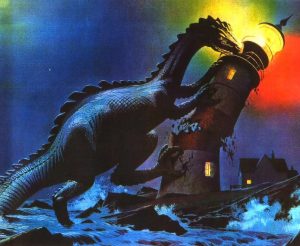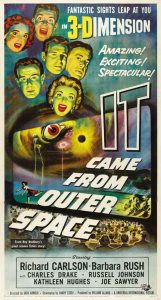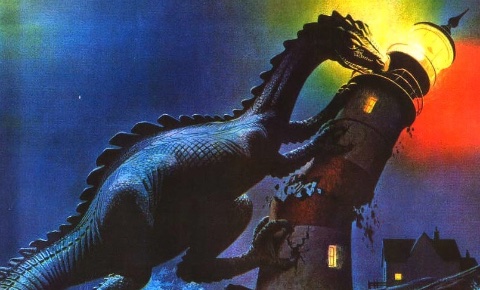 From a very early age, Ray Bradbury had a love for the cinema. His passion was born through his mother, Esther Bradbury. In 1924, she began taking her son — not yet four years old — to the movies in downtown Waukegan, Illinois. The first film that they saw together was Lon Chaney’s THE HUNCHBACK OF NOTRE DAME. According to Bradbury biographer, Sam Weller, “this movie laid the groundwork in his fertile mind for what would later become Ray’s trademark — the strange, the fantastic, the imaginative all wrapped up in a story most decidedly human. . . . THE HUNCHBACK OF NOTRE DAME ignited a lifelong love of film — a medium that later forged his keen sense of story and his grasp of quick narrative movement.”
From a very early age, Ray Bradbury had a love for the cinema. His passion was born through his mother, Esther Bradbury. In 1924, she began taking her son — not yet four years old — to the movies in downtown Waukegan, Illinois. The first film that they saw together was Lon Chaney’s THE HUNCHBACK OF NOTRE DAME. According to Bradbury biographer, Sam Weller, “this movie laid the groundwork in his fertile mind for what would later become Ray’s trademark — the strange, the fantastic, the imaginative all wrapped up in a story most decidedly human. . . . THE HUNCHBACK OF NOTRE DAME ignited a lifelong love of film — a medium that later forged his keen sense of story and his grasp of quick narrative movement.”
The author himself noted, “When I talk of myself as being a child of my time, perhaps the biggest truth is that I am a cinematic child of my time, in that this influence has probably had a lot to do with the direction my writing has taken over the years, the type of writing I have done, and the way I have expressed myself.”
Ray Bradbury’s stories are visual, almost cinematic. Hence the wonderful EC Comics adaptations by Johnny Craig, Jack Davis, Joe Orlando, Al Williamson, Wally Wood, and other artists. It’s also one of the reasons that Mutual Pictures of California bought the movie rights to his short story, “The Beast from 20,000 Fathoms.” Bradbury later called his story “The Foghorn,” for its publication in THE GOLDEN APPLES OF THE SUN (1953).
Originally published in the June 23, 1951 issue of THE SATURDAY EVENING POST, Bradbury’s story concerns a lovelorn sea serpent, “. . . hid away in the Deeps. Deep, deep down in the deepest Deeps.” Hearing the call of a lonely fog horn, the creature leaves its cold and dark lair to seek another of its kind. Sadly, all the monster finds is the lighthouse and its foghorn. In anguish, the dinosaur destroys the lighthouse and returns to “the deepest Deeps.”
Hoping to capitalize on Ray Bradbury’s growing popularity and reputation, producers Jack Dietz and Hal E. Chester changed the name of their film — THE MONSTER FROM BENEATH THE SEA — to match the POST story. They also gave Bradbury story credit and promoted their film with his name. The author’s only contribution to the film is the lighthouse attack scene.
Released by Warner Brothers in 1953 and featuring animation effects by Ray Bradbury’s close friend, Ray Harryhausen, THE BEAST FROM 20,000 FATHOMS was the first of the atomic monster films. Its financial success led to the many giant monster movies of the 1950s and 60s, including Ishirō Honda’s GODZILLA (1954). The film also helped to launch Ray Harryhausen’s lauded career as the master of “Dynamation.”
While Chester and Dietz were interested in acquiring the rights to Ray Bradbury’s story to capitalize on his popularity, Universal Pictures had other plans for the author. Although likely knowing of his stature as a leading science fiction author, the studio approached him in 1952 to help them develop a monster movie.
Ever ambitious, Bradbury offered Universal two choices: he’d develop a screen treatment about a bug-eyed-monster attacking Earth or a story about aliens arriving on our planet without harmful intent.
“I wanted to treat the invaders as beings who were not dangerous, and that was very unusual. The only other film like it was THE DAY THE EARTH STOOD STILL, two years before. These two films stand out as treating creatures who understand humanity. The studio picked the right concept and I stayed on.”
According to Sam Weller’s THE BRADBURY CHRONICLES: Bradbury’s work for Universal “. . . went far beyond the parameters of the normal, present-tense, narrative film treatment. The final 111-page outline, completed in early October, was heavy on dialogue and camera direction. It was a point-by-point, scene-by-scene blueprint for a writer to adapt into script form.” The film’s screenwriter Harry Essex later suggested: “Ray Bradbury wrote a screenplay and called it a treatment.”
 Director Jack Arnold’s IT CAME FROM OUTER SPACE was released on May 25, 1953, and was “immediately recognized as a groundbreaking work of 1950s science fiction paranoia, echoing the burgeoning national obsession with Martians, flying saucers, and incidents like the alleged 1947 crash of an alien craft in the desert outside Roswell, New Mexico. . . . instead of rehashing the tired cliché of an intergalactic monster set to devour civilization, he flipped the space-invader genre on its collective ear by portraying human beings as the real villains of the story.”
Director Jack Arnold’s IT CAME FROM OUTER SPACE was released on May 25, 1953, and was “immediately recognized as a groundbreaking work of 1950s science fiction paranoia, echoing the burgeoning national obsession with Martians, flying saucers, and incidents like the alleged 1947 crash of an alien craft in the desert outside Roswell, New Mexico. . . . instead of rehashing the tired cliché of an intergalactic monster set to devour civilization, he flipped the space-invader genre on its collective ear by portraying human beings as the real villains of the story.”
IT CAME FROM OUTER SPACE was Universal’s first science fiction film and their first official 3-D release. In later years, filmmaker Steven Spielberg credited IT CAME FROM OUTER SPACE as an inspiration for CLOSE ENCOUNTERS OF THE THIRD KIND. Apparently, he had seen it six times as a kid.
Although Ray Bradbury would be part of the Hollywood scene for many years to come — he would write the screenplay for John Huston’s MOBY DICK (1956), help get THE TWILIGHT ZONE off the ground, co-direct the reshoots for Disney’s SOMETHING WICKED THIS WAY COMES (1983), script all 65 episodes of THE RAY BRADBURY THEATER (1985 – 1992), win an Emmy Award for THE HALLOWEEN TREE in 1994, and more — these two fifties B-movies were perhaps the most influential works of cinema to be associated with the author.
PulpFest 2020 is very pleased to highlight THE BEAST FROM 20,000 FATHOMS and IT CAME FROM OUTER SPACE as part of its celebration of the 100th anniversary of the birth of author Ray Douglas Bradbury.
(Pictured here are James R. Bingham’s interior illustration for Ray Bradbury’s “The Beast From 20,000 Fathoms,” from THE SATURDAY EVENING POST for June 23, 1951, as well as one of the movie posters advertising the 1953 Universal Pictures release. The art is probably the work of Joseph Smith. Directly below “SPACE” in the title logo of the movie poster are the words: “From Ray Bradbury’s great science fiction story.” You can’t shut a great author out!)







